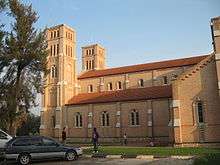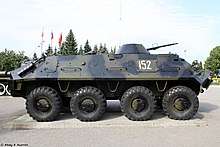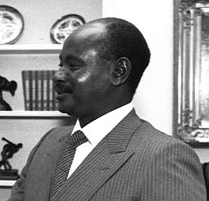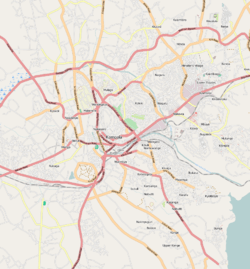Battle of Kampala
The Battle of Kampala was a battle of the Ugandan Bush War that took place from 17 to 26 January 1986 in which forces of the National Resistance Army (NRA) attacked and captured the Ugandan capital, Kampala, from the Uganda National Liberation Army (UNLA). As a result, the Ugandan government was deposed and replaced by a new one under NRA leader Yoweri Museveni.
In 1981 Museveni initiated an insurgency in Uganda against the government, which was controlled by the Uganda National Liberation Front (UNLF). He soon joined the nascent National Resistance Movement (NRM) and took control of its armed wing, the NRA. In 1985 the NRA inflicted several key defeats on the UNLF's armed wing, the UNLA, leaving the Ugandan capital, Kampala, vulnerable to attack. Feeling pressured, the UNLF government led by President Tito Okello pursued negotiations with the NRM. The resulting peace agreement failed to end the conflict, and Okello amassed a large force of UNLA troops and allied militias to garrison Kampala in preparation for an attack, though its effectiveness was weakened by low morale, internal friction, and subterfuge. On 17 January 1986 the NRA began advancing on Kampala. They managed to occupy territory around the city, but the UNLA stemmed their advance by placing an artillery battery at a strategic roundabout. On 24 January the UNLA withdrew its battery, and the NRA began its main attack.
On the following day the NRA besieged several UNLA installations in Kampala, and by evening had secured Republic House, the UNLA headquarters. On 26 January the NRA captured Radio Uganda, but 1,000 UNLA troops from Entebbe broke through a roadblock and began advancing towards the city. Museveni and his chief of staff, Salim Saleh, redeployed their forces to counter the threat, in the process opening a gap in their cordon around Kampala and allowing many UNLA troops to escape. Okello fled in a helicopter and flew to Sudan. In the evening an NRA battalion ambushed the UNLA troops advancing from Entebbe while a company moved to attack their rear, forcing them to capitulate and ending the battle. On 29 January Museveni was sworn in as President of Uganda. The UNLA attempted to regroup in northern Uganda, but collapsed in the following months after being subject to further NRA attacks.
Background
In April 1979 Tanzanian forces and the Uganda National Liberation Army (UNLA), a coalition of armed rebel groups united under the Uganda National Liberation Front (UNLF), deposed the President of Uganda, Idi Amin. A new UNLF government was installed, but it was weak and exercised little control over the country.[1] This was in part due to the UNLF's and its army's own internal divisions. The several-hundred strong Kikosi Maalum group was loyal to Milton Obote, who had served as President before Amin took power. Yoweri Museveni controlled the Front for National Salvation, which had about 3,000 members.[2] Over time power shifted to pro-Obote elements in the government and the army.[3] Obote assumed power in 1980 through a disputed election, and ruled through repressive methods, including the incarceration and killing of dissidents.[4][5] In February 1981 Museveni and a small band of rebels began attacking UNLA forces, initiating the Ugandan Bush War. Shortly thereafter a new rebel coalition was organised as the National Resistance Movement (NRM). Museveni was made Vice-Chairman of the National Resistance Council, the group's political body, and Chairman of the High Command of the National Resistance Army (NRA), the Movement's armed organ.[6] By July 1985 the NRA had been largely defeated and pushed out of its strongholds, and Museveni retired to Sweden.[7]
On 27 July, several officers of the UNLA launched a coup which overthrew President Obote. General Tito Okello assumed power in his place. The new regime was weak and unstable, and Okello made overtures to anti-Obote rebel groups to form a coalition government and end the fighting.[8] The coup upset many Lango soldiers, which constituted the second-largest ethnic group in the UNLA and were loyal to Obote.[9] The NRM was highly critical of the new government and accused the UNLA of committing atrocities. The UNLF, conscious of its weakening political position, nevertheless pursued negotiations with the NRM.[8] Museveni took advantage of the disruption caused by the coup to return to East Africa and rebuild the NRA.[10] In August the NRA launched a series of co-ordinated attacks that resulted in the capture of significant amounts of territory in central and western Uganda.[11] In late September, the NRA laid siege to the UNLA troops in the provincial centre of Masaka and, soon thereafter, the town of Mbarara, both key urban areas in southern Uganda.[12] In October Museveni warned that, in the event of the failure negotiations ongoing between the NRM and the UNLF in Nairobi, "the NRA would take Kampala by force".[13] On 3 December Okello's government released a document allegedly seized from the NRA which carried an order from Museveni to the NRA Chief of Staff, Salim Saleh, to prepare to attack the Ugandan capital, Kampala, if a peace agreement did not materialise. The NRM did not comment on the disclosure.[13] On 10 December Masaka's garrison surrendered to the NRA.[14] On 17 December the UNLF and NRM concluded talks and signed the Nairobi Peace Agreement. The accord nominally ended the war and declared Okello and Museveni President and Vice President of Uganda, respectively,[8] and required the demilitarisation of Kampala until a new army could be established.[15] It also carried a provision which stipulated that one belligerent could disregard the agreement if the other was found to be violating human rights. The NRM accused the UNLA of failing to respect Ugandans' rights, and the NRA continued fighting.[8] On 31 December the UNLF government accused the NRA of failing to uphold its terms of the peace agreement by launching attacks, impeding the flow of food to the Mbarara garrison, and refraining from nominating representatives to coordinate further peace measures with the government.[13] The UNLA forces at Mbarara capitulated soon thereafter.[16]
Prelude
Following their victories, the NRA was able to greatly expand its manpower, and gained access to important military equipment. In contrast, the UNLA's remaining forces were increasingly suffering from defections, low morale, and internal divisions along ethnic lines.[16] The NRA's success at Masaka and Mbarara also solidified their control of the centre and south-western sections of the country and left Kampala vulnerable to attack.[17] To take advantage of its improving military situation, the NRA High Command decided to launch an offensive to capture the city.[16] Saleh drew up the plans of attack.[18] About 9,600 fighters were allocated for this operation,[16] many of which were UNLA defectors from the Masaka garrison.[14] At the same time, the NRA's 9th and 19th Battalions blocked the Masinda–Hoima Road, so that UNLA units which were still active in northern Uganda could not reinforce Kampala.[16] Realising that the rebels would launch an attack on the capital, President Okello attempted to bolster Kampala's garrison by enlisting the aid of anti-NRA militias, including the Former Uganda National Army (FUNA) and the Uganda Freedom Army. In truth, many of these alleged anti-NRA fighters were NRA spies and acted as a fifth column. The entire Uganda Freedom Army was probably a front organisation of the NRA.[19] In addition, FUNA suffered from extensive indiscipline, and harassed civilians in the capital despite denials by its commander Isaac Lumago.[20] Kampala's garrison was at least 12,000-strong.[21] The UNLA also established a battery at Summit View on Kololo, a hill overlooking Kampala.[22][lower-alpha 1] Troops were deployed to strategic locations, including the Radio Uganda building, the Uganda Television building, the Nile Mansions, the Uganda International Conference Centre, and the Parliament building. UNLA forces also garrisoned the State House in Entebbe to the south-east.[24]
Battle

On 17 January 1986 the NRA began advancing on Kampala. The NRA's 1st, 3rd, 5th and 11th Battalions moved along the main axis of attack from Masaka, while the 7th Battalion travelled down Hoima Road towards the city.[22] UNLA troops were sent to intercept them south-west of the city, but they withdrew and ignored their officers' orders for them to return.[25] On 20 January the UNLA's battery began shelling western Kampala. The bombardment targeted the Rubaga Cathedral, which the UNLA suspected had been infiltrated by the NRA.[24] By 22 January the NRA's 7th Battalion had occupied Nansana, while the 1st, 3rd, 5th and 11th Battalions had taken up position on Mutundwe, another hill overlooking Kampala.[22] UNLA and FUNA troops blocked their advance by placing artillery—including anti-aircraft guns— at the Busega roundabout,[22][21] where the Masaka and Fort Portal roads entered the capital. The commander of the NRA's 1st Battalion, Pecos Kutesa, in a fit of anxiety claimed he was ill; Museveni ordered him to remain at the local NRA headquarters while his second-in-command, Fred Mugisha took charge of the unit on the front lines.[22]
On 24 January the UNLA withdrew from the Busega roundabout.[22] A band of NRA soldiers led by Kasirye Gwanga reconnoitred the area, and, discovering that it had been abandoned, radioed a message to their headquarters.[26] Saleh and Museveni subsequently ordered their forces to attack. The 1st Battalion and 3rd Battalion were given the responsibility of conducting the main thrust into Kampala and equipped with most of the NRA's support weapons. The former pressed forward with the latter in support, and by nightfall had secured Rubaga. The 11th Battalion moved in behind them, while the 7th Battalion seized Ndeeba. Upon hearing that his troops had entered Kampala, Museveni relocated his headquarters from Mpigi to Trinity College Nabbingo.[27] Meanwhile, three young NRA guerrillas reconnoitred UNLA defences on Kololo under the guise of playing football.[28] For the most part, the UNLA and FUNA soldiers defending the city were demotivated and poorly led; many deserted or outright defected to the NRA.[21]
On 25 January the NRA's 7th Battalion attacked the UNLA barracks at Makindye and the 3rd Battalion assaulted the Lubiri barracks, while the 1st Battalion acted as a reserve.[27] NRA artillery positioned on Mutundwe traded fire with the UNLA battery at Summit View.[22] Fighting at Lubiri was severe;[27] the UNLA garrison successfully blunted an attempt by NRA troops to scale the barracks wall, so the latter resorted to besieging the installation with grenades and machine guns.[22] All foreign missions in the city closed their facilities.[25] The governments of the United States and the United Kingdom advised their nationals in the capital to seek shelter indoors.[29] Radio Uganda broadcast a request from Okello to the NRA for a ceasefire and for the implementation of the Nairobi Peace Agreement.[25] In the afternoon NRA artillery struck an armoury near the UNLA's headquarters, Republic House, causing a large series of explosions.[27] Republic House was captured early in the evening by the 1st and 3rd Battalions. At about 21:00 a platoon of the 3rd Battalion managed to successfully climb over the wall at the Lubiri barracks, finding the location to have been abandoned by UNLA forces. Saleh moved to join his troops at the front line and encamped at Natete.[30]

On 26 January Museveni went to Republic House, moving his command post to its canteen. He was greeted by Saleh, who briefed him on the status of the battle. The NRA's 1st Battalion was subsequently ordered to secure the city centre.[30] Along Parliament Avenue an NRA BTR-60 armoured personnel carrier (APC) was struck by a UNLA rocket-propelled grenade (RPG). The APC attempted to reverse to evade further fire but collided with a lorry which was hauling a 37 mm anti-aircraft gun. UNLA troops subsequently set both vehicles ablaze, and Radio Uganda—which had been broadcasting UNLA propaganda throughout the battle—declared that an NRA tank had been destroyed. Soldiers of the 1st Battalion and 3rd Battalion led by Mugisha and Patrick Lumumba employed RPGs to eliminate UNLA anti-armour defences around Radio Uganda.[31] By 15:00 the NRA had secured the Radio Uganda station,[32] killing a UNLA officer and capturing three soldiers.[33] Meanwhile, the 11th Battalion under Chefe Ali[22] captured Nakulabye, Makerere, and Kamwokya.[32] The unit then rushed the UNLA position at Summit View, forcing the troops manning the artillery to surrender[22] and forcing others—including their commanding officer, Lieutenant Colonel Eric Odwar—to retreat.[32] Telecommunications running out of the country were severed.[34] By the afternoon, UNLA troops still held out at the Nile Mansions, and the Parliament building.[35]
While the 7th Battalion continued to battle the Makindye garrison, a UNLA force of about 1,000 men penetrated the NRA's 5th Battalion's roadblock along the Entebbe road, causing Museveni deep consternation. As the 1st Battalion was engaged near the Jinja road and the 11th Battalion was mopping up the UNLA presence on Kololo, he deployed his reserve—two companies of the 3rd Battalion—to stop the advance from Entebbe.[32] Saleh ordered the NRA's 500-strong Special Force under Jet Mwebaze to redeploy from a roadblock on the Jinja road to assist Ivan Koreta's 13th Battalion in the northern section of the city near the Gulu road. After some fighting, the battalion reached and secured Kawempe. With the removal of the roadblock on the Jinja road, UNLA forces began retreating from Kampala, taking their families with them.[36]
Saleh accompanied the 3rd Battalion companies to Namasuba valley where they linked up with a company of the 5th Battalion and took up positions along the Entebbe road.[37] Early in the evening the 7th Battalion captured the Makindye barracks, and Museveni sent them to the Kisubi roundabout to act as a reserve for the forces guarding the Entebbe route. As dusk fell, the 1,000 UNLA troops entered the Namasuba valley and were ambushed. They retreated, and the NRA forces advanced and occupied Zana hill. Another NRA company stationed at Kisubi began moving towards the UNLA force's rear. Fearing that they were about to be subject to a pincer attack, the UNLA men dispatched an emissary to Zana to offer their surrender. Saleh accepted, and at around 22:00 radioed news of the capitulation to Museveni.[38] By the end of the day the NRA had secured Kampala.[22] Saleh went to Radio Uganda link up with the 1st Battalion and sleep.[39] Three high-ranking UNLA commanders surrendered when the city fell to the NRA; namely chief of staff Lieutenant General Zeddy Maruru, Brigadier Fred Okecho, and Colonel Samuel Nanyumba.[40] Okello fled via helicopter to Sudan with several members of his staff.[41][lower-alpha 2] FUNA commander Isaac Lumago went into exile in Zaire.[42]
Aftermath
Analyses
The Battle of Kampala was the largest battle the NRA had partaken in since its inception.[43] Researcher Richard J. Reid described the UNLA's defense of Kampala as "brief but ferocious".[44] Unlike previous, drawn-out engagements in the Ugandan Bush War, the NRA had won the battle through overwhelming force and direct attack.[45] The removal of the NRA roadblock on the route to Jinja allowed many UNLA troops to escape the city and reorganise to launch a new rebellion eight months later. Saleh maintained that he had ordered the roadblock's removal in consideration of "humanitarian reasons", as there could have been "a blood bath and [UNLA troops'] families would perish in the fighting".[46] In contrast, historians Tom Cooper and Adrien Fontanellaz regarded the roadblock's removal as the result of "a faulty order".[21]
Course of the war

Overall, about 20 NRA and 80 UNLA/FUNA soldiers were killed in the fighting, while nearly 3,000 UNLA troops were captured.[21] Most of the UNLA casualties were incurred as troops were shot while attempting to abandon their positions at Radio Uganda and Uganda Television and flee towards Kololo.[33] About 9,000 UNLA soldiers and their families managed to escape from Kampala. Many of these troops retreated towards Jinja and Gulu,[21] looting as they fled.[40][47] Buildings along Kampala Avenue, the main road in the city, were left heavily damaged by the battle.[48] Unlike previous military takeovers in Kampala, the NRA soldiers did not loot in the city.[49] Following the battle, the NRA's 5th Battalion and one platoon from the 3rd Battalion captured Entebbe.[39]
On 29 January Museveni was sworn in as President of Uganda in front of the Parliament building with a crowd of tens of thousands in attendance.[33] In his inaugural address, he promised to support national unity, public security, and democracy, pledging that his government would schedule elections as soon as possible.[50] His appointed cabinet consisted mostly of NRM members and civil servants.[51] Despite Museveni's promises, many northerners in Kampala—viewed as beneficiaries of the Obote and Okello regimes—especially Acholi and Lango people, were subject to abuse and discrimination following the NRA's takeover; some were killed in the streets or forced out of their jobs or homes. Several NRA soldiers stole automobiles from them. Other northerners fled from the repression to their lands of origin.[52] Museveni condemned the violence.[53]
Museveni's government sent an emissary to Sudan to entreat Okello to order the remaining UNLA forces to surrender, but he stated that he no longer controlled them.[41] The NRA subsequently attacked Jinja, capturing it by late January, followed by Tororo in early February. At this point, UNLA attempted one last time to stem the rebel advance by launching a counter-attack against Tororo and fortifying the crossings of the Nile to prevent the NRA from advancing into northern Uganda. Nevertheless, Museveni's forces inflicted further defeats on the UNLA in late February and early March, resulting in the complete collapse of the latter.[21] A presidential election was not held in the country until 1996; Museveni won by a large margin.[54]
Notes
- According to NRA fighter Pecos Kutesa, North Korean technicians helped the UNLA to set up the artillery at Summit View.[22] This is unlikely, however, as all North Korean advisors reportedly left Uganda in August 1985.[23]
- It was rumored during the battle that Okello had initially retreated to Jinja.[35]
Citations
- Kasozi 1994, p. 129.
- Kasozi 1994, pp. 129–130.
- Kasozi 1994, p. 133.
- Kasozi 1994, pp. 128, 163–164.
- "Uganda : History". Encyclopedia Britannica. Retrieved 3 July 2019.
- Kasozi 1994, pp. 164–165.
- Legum 1987, pp. B-466, B-475.
- "Today in History: How Museveni was appointed vice-president". New Vision. 27 July 2018. Retrieved 29 June 2019.
- Legum 1987, p. B-464.
- Legum 1987, p. B-466.
- Cooper & Fontanellaz (2015), p. 49.
- Kainerugaba 2010, pp. 143, 149, 155, 172.
- Legum 1987, p. B-470.
- Kainerugaba 2010, p. 149.
- Legum 1987, p. B-471.
- Cooper & Fontanellaz (2015), p. 50.
- Kainerugaba 2010, p. 155.
- Rwomushana, Namara (3 April 2016). "A look back at Salim Saleh's 40-year liberation journey". Daily Monitor. Retrieved 29 June 2019.
- Cooper & Fontanellaz (2015), pp. 50–51.
- Harden, Blaine (20 January 1986). "Ugandans Learn to Live With Chronic Tribal War". The Washington Post. Retrieved 16 December 2019.
- Cooper & Fontanellaz (2015), p. 51.
- Kutesa, Pecos (22 January 2010). "How Kampala fell". New Vision. Retrieved 23 June 2019.
- Legum 1987, p. B-467.
- Lamwaka 2016, p. 1.
- Rule, Sheila (25 January 1986). "Combat Said to Rage in Uganda Capital". The New York Times. pp. 1, 3.
- Ggwanga, Kasirye (9 February 2004). "NRM BUSH WAR MEMORIES: Risking all to avenge a brother's death - Col. Ggwanga". Daily Monitor. Retrieved 24 June 2019.
- Kainerugaba 2010, p. 165.
- Hall, Richard (1 February 1986). "How Child's Play Toppled Kampala". Chicago Tribune (national, C ed.). p. 5.
- "Americans Reported Safe". The New York Times. Reuters. 26 January 1986. p. 1. Retrieved 30 July 2019.
- Kainerugaba 2010, p. 166.
- Kainerugaba 2010, p. 167.
- Kainerugaba 2010, p. 168.
- Lamwaka 2016, p. 6.
- Harden, Blaine (26 January 1986). "Ugandan Capital Said to Fall". The Washington Post. Retrieved 30 July 2019.
- Sheila Rule (26 January 1986). "Rebels in Uganda take control of capital, but Battles continue". The New York Times. p. 1. Retrieved 30 December 2019.
- Kainerugaba 2010, pp. 169, 179.
- Kainerugaba 2010, p. 169.
- Kainerugaba 2010, p. 170.
- Kainerugaba 2010, p. 171.
- Kitaka, Edward (28 January 1986). "Museveni Sworn in As President". Associated Press. Retrieved 28 July 2019.
- "Deposed head of state Gen. Tito Okello said he..." United Press International. 13 February 1986. Retrieved 4 July 2019.
- Rice 2003, p. 7.
- Kainerugaba 2010, p. 177.
- Reid 2017, p. 78.
- Kainerugaba 2010, p. 172.
- Kainerugaba 2010, p. 179.
- Freudenheim, Milt; Levine, Richard (2 February 1986). "Uganda Swears In A Leader and Buries Its Dead". The New York Times. Retrieved 4 July 2019.
- Sheppard, Nathaniel, Jr. (30 January 1986). "New Battlefields for Uganda Leader". Chicago Tribune. p. 8.
- Lamwaka 2016, p. 5.
- "New leader inaugurated in Kampala". The Globe and Mail. 30 January 1986. p. A16.
- "Museveni to rebuild Ugandan military, but rules out elections for three years". The Citizen. 1 February 1986. p. A14.
- Lamwaka 2016, pp. 8–9.
- Lamwaka 2016, p. 10.
- "Ugandan voters pick ex-dictator as president". Toronto Star. Reuters. 12 May 1996. p. A11.
References
- Cooper, Tom; Fontanellaz, Adrien (2015). Wars and Insurgencies of Uganda 1971–1994. Solihull: Helion & Company Limited. ISBN 978-1-910294-55-0.CS1 maint: ref=harv (link)
- Lamwaka, Caroline (2016). The Raging Storm: A Reporter's Inside Account of the Northern Uganda War, 1986-2005. Kampala: Fountain Publishers. ISBN 978-9970-25-221-3.CS1 maint: ref=harv (link)
- Legum, Colin, ed. (1987). Africa Contemporary Record : Annual Survey and Documents : 1985–1986. 18. New York City & London: Africana Publishing Company. ISBN 978-0-8419-0556-6.CS1 maint: ref=harv (link)
- Kainerugaba, Muhoozi (2010). Battles of the Ugandan Resistance: A Tradition of Maneuver. Kampala: Fountain Publishers. ISBN 978-9970-25-032-5.CS1 maint: ref=harv (link)
- Kasozi, A. (1994). Social Origins of Violence in Uganda, 1964-1985. Montreal: McGill-Queen's Press. ISBN 978-0-7735-6487-9.CS1 maint: ref=harv (link)
- Reid, Richard J. (2017). A History of Modern Uganda. Cambridge: Cambridge University Press. ISBN 978-1-107-06720-2.CS1 maint: ref=harv (link)
- Rice, Andrew (1 September 2003). "Thin" (PDF). Institute of Current World Affairs Letters. AR (13).CS1 maint: ref=harv (link)
